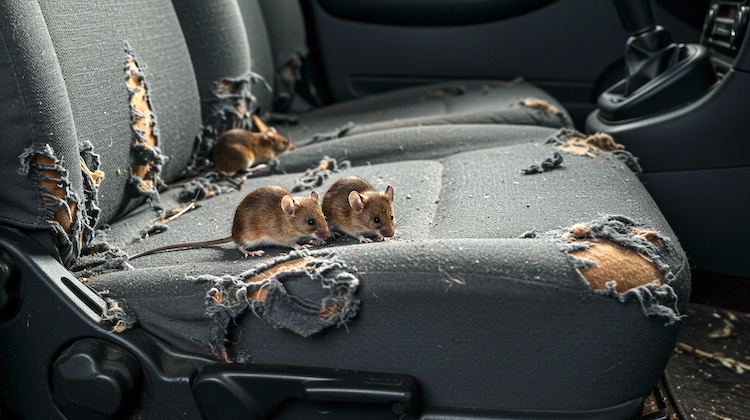
If you work in an auto upholstery shop long enough, you’re bound to run into it — a car that’s been sitting for years, brought in for new trim work, and hiding a nasty surprise: a mouse nest.
It’s not just a dirty inconvenience. Rodents can leave behind serious problems, including chewed foam, shredded fabric, and damaged wiring. Worse yet, mouse nests are hazardous to your health. Droppings, urine, and nesting materials can spread diseases like hantavirus, leptospirosis, and salmonella. Even breathing in dust from a contaminated interior can trigger serious respiratory issues if you’re not careful.
I recently ran into this situation while replacing the headliner on a 1969 Chevy Camaro. At first, I spotted just a small hole chewed through the fabric and hoped it was a minor issue. But as I dropped the headliner, I found the entire thing was covered in feces and urine. What was supposed to be a simple headliner replacement quickly turned into a full-blown hazmat cleanup — costing a lot more time, effort, and risk than originally expected.
That’s why many shops charge an additional fee when they find rodent nests. But how you go about it matters. Here’s a breakdown of the most common approaches — and the pros and cons of each:
Flat Cleaning Fee
How it works: Shops charge a predetermined, fixed fee whenever a mouse nest is found.
Pros:
- Easy to explain to customers.
- No need to estimate or track additional labor.
- Predictable extra income for unexpected messes.
Cons:
- Some nests are minor; customers might feel overcharged.
- Some nests are severe; the shop could lose money if the fixed fee doesn’t cover the extra time, supplies, and protective gear needed for safe cleanup.
Hourly Labor Rate
How it works: Shops bill additional time spent cleaning and repairing rodent damage at their standard hourly labor rate.
Pros:
- Fair compensation based on the actual amount of work.
- Easier to justify charges when customers ask for a breakdown.
Cons:
- Standard labor rates usually assume clean, routine work — not dealing with hazardous, unsanitary conditions that require extra care and safety measures.
- Many shop owners feel that the disgusting and risky nature of the job deserves more than their normal hourly rate.
- Tracking every extra minute can become tedious and cause billing disputes.
Case-by-Case Basis
How it works: Shops assess the situation individually and quote an additional fee based on the severity of the infestation.
Pros:
- Flexible approach that matches the level of work required.
- Allows shops to adjust pricing depending on how messy, hazardous, or labor-intensive the job is.
Cons:
- Can lead to inconsistency in pricing.
- Might cause customer confusion or disputes if fees seem arbitrary.
Regardless of the method, one thing is clear: Dealing with mouse nests is dirty, dangerous work that goes far beyond the typical scope of upholstery repair. Shop owners should think carefully about how they structure their pricing to make sure they’re fairly compensated for the extra time, effort, materials, and health risks involved.
Having a clear policy in place — and communicating it upfront — can save a lot of headaches when the next nasty surprise rolls into the shop.
Leave a Reply